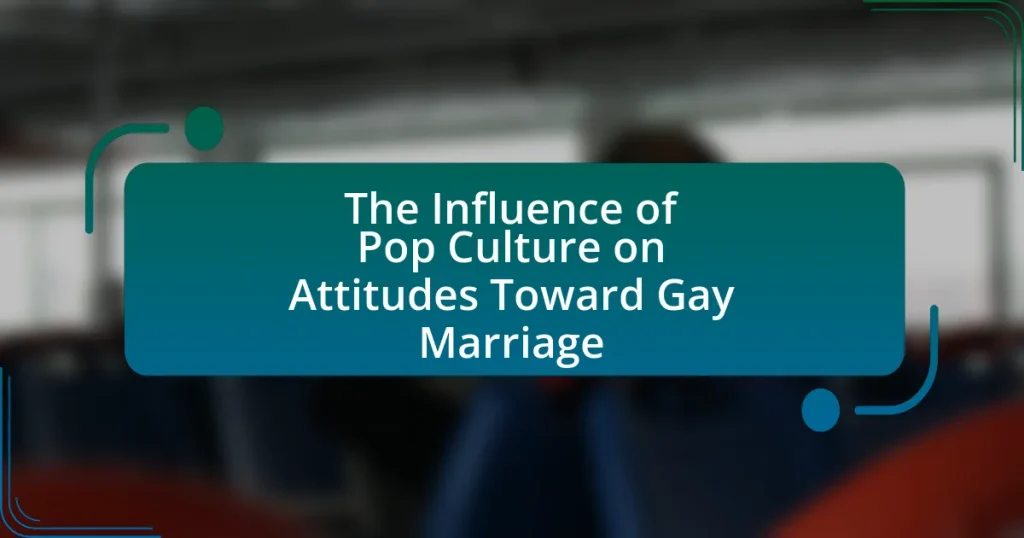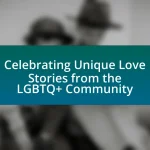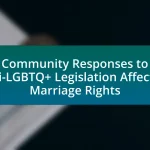The article examines the significant influence of pop culture on attitudes toward gay marriage, highlighting how media representation normalizes LGBTQ+ relationships and fosters acceptance. It discusses historical and contemporary examples, such as the impact of television shows like “Will & Grace” and films like “Brokeback Mountain,” which have shifted public perceptions and increased support for marriage equality. Additionally, the role of celebrities and social media in advocating for gay marriage rights is explored, along with the implications of these cultural narratives on legislative changes. The article also addresses ongoing challenges in representation and the potential strategies for leveraging pop culture to further promote acceptance of gay marriage.
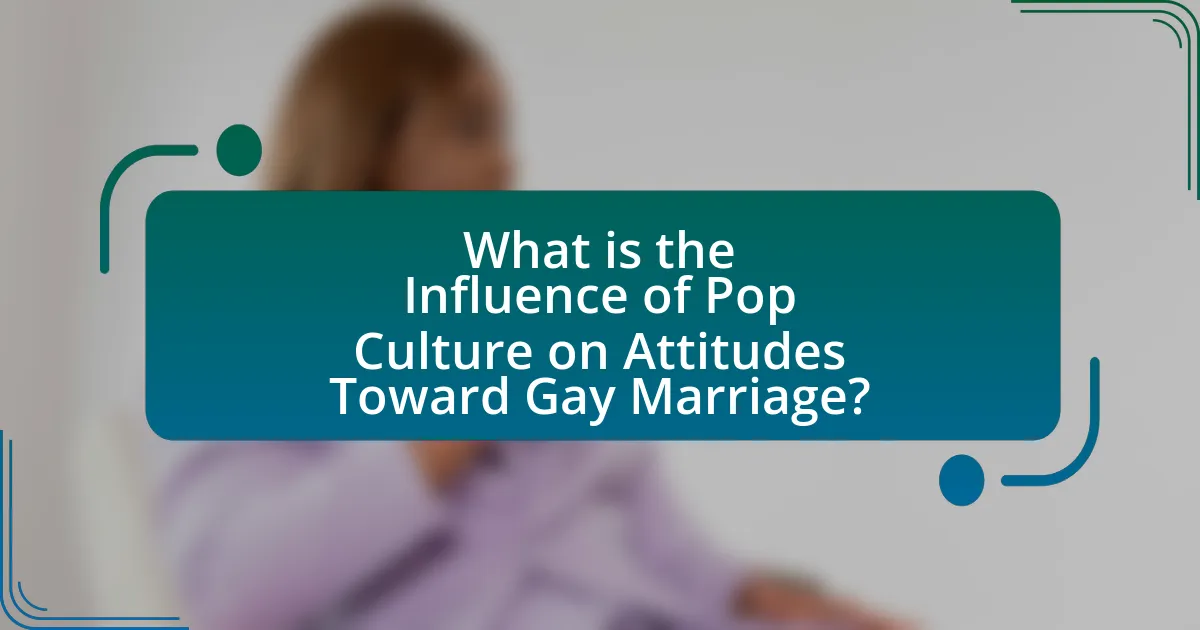
What is the Influence of Pop Culture on Attitudes Toward Gay Marriage?
Pop culture significantly influences attitudes toward gay marriage by normalizing LGBTQ+ relationships and promoting acceptance through various media platforms. Television shows, movies, and music often feature LGBTQ+ characters and storylines, which can lead to increased visibility and understanding. For example, the television series “Will & Grace” played a pivotal role in changing perceptions of gay relationships in the late 1990s and early 2000s, contributing to a more favorable public opinion on gay marriage. Research indicates that exposure to positive representations of LGBTQ+ individuals in pop culture correlates with greater acceptance of gay marriage, as seen in studies conducted by the Williams Institute, which found that states with more LGBTQ+ representation in media showed higher support for marriage equality.
How has pop culture historically shaped societal views on gay marriage?
Pop culture has historically shaped societal views on gay marriage by normalizing LGBTQ+ relationships through media representation. Television shows like “Will & Grace,” which premiered in 1998, played a significant role in bringing gay characters into mainstream narratives, fostering acceptance and understanding among viewers. Additionally, films such as “Brokeback Mountain” (2005) highlighted the complexities of same-sex love, contributing to a broader dialogue about LGBTQ+ rights. These representations have influenced public opinion, as studies indicate that increased visibility of gay relationships in media correlates with greater support for marriage equality, evidenced by a 2015 Gallup poll showing that 60% of Americans supported same-sex marriage, a significant increase from 27% in 1996.
What key moments in pop culture have influenced public perception of gay marriage?
Key moments in pop culture that have influenced public perception of gay marriage include the television show “Will & Grace,” which debuted in 1998 and normalized gay relationships for mainstream audiences, and the Supreme Court’s 2015 ruling in Obergefell v. Hodges, which legalized same-sex marriage nationwide. The portrayal of LGBTQ+ characters in popular media, such as in films like “Brokeback Mountain” (2005) and “Moonlight” (2016), has also contributed to shifting societal attitudes. Additionally, high-profile celebrity endorsements, such as those from Ellen DeGeneres and Neil Patrick Harris, have played a significant role in advocating for marriage equality and increasing visibility. These cultural milestones have collectively fostered greater acceptance and understanding of gay marriage in society.
How do media representations of LGBTQ+ relationships impact attitudes toward gay marriage?
Media representations of LGBTQ+ relationships significantly influence attitudes toward gay marriage by normalizing and humanizing these relationships in society. Research indicates that positive portrayals of LGBTQ+ couples in television and film lead to increased acceptance and support for same-sex marriage among viewers. For instance, a study published in the journal “Communication Research” found that exposure to LGBTQ+ characters in popular media correlates with more favorable attitudes toward gay marriage, particularly among younger audiences. This effect is attributed to the ability of media to challenge stereotypes and foster empathy, ultimately contributing to a shift in public opinion toward greater acceptance of LGBTQ+ rights, including marriage equality.
What role do celebrities play in shaping attitudes toward gay marriage?
Celebrities play a significant role in shaping attitudes toward gay marriage by leveraging their visibility and influence to promote acceptance and support for LGBTQ+ rights. Their public endorsements and personal stories often resonate with fans, leading to increased awareness and normalization of gay marriage. For instance, studies have shown that when high-profile figures, such as Ellen DeGeneres and Neil Patrick Harris, publicly advocate for gay marriage, there is a measurable shift in public opinion, particularly among younger demographics. Research from the Williams Institute indicates that celebrity advocacy can lead to a 10-20% increase in support for same-sex marriage in specific populations. This demonstrates that celebrities not only influence individual attitudes but also contribute to broader societal changes regarding LGBTQ+ acceptance.
How do celebrity endorsements affect public opinion on gay marriage?
Celebrity endorsements significantly influence public opinion on gay marriage by leveraging their visibility and social capital to normalize and support the issue. Research indicates that when celebrities publicly advocate for gay marriage, they can shift perceptions and increase acceptance among their fans and the general public. For instance, a study published in the Journal of Communication found that celebrity endorsements can lead to increased support for LGBTQ+ rights, with 63% of respondents indicating that a celebrity’s support positively influenced their views on gay marriage. This effect is particularly pronounced among younger demographics, who are more likely to be swayed by public figures they admire.
What examples exist of celebrities advocating for gay marriage rights?
Numerous celebrities have actively advocated for gay marriage rights, significantly influencing public opinion. For instance, Ellen DeGeneres publicly came out as gay in 1997 and has since been a vocal supporter of LGBTQ+ rights, including marriage equality, using her platform to promote acceptance and legal recognition. Similarly, singer Lady Gaga has been a prominent advocate, famously stating that “marriage is a human right” and participating in campaigns like “Born This Way” to support LGBTQ+ rights. Additionally, actor George Clooney has spoken out in favor of gay marriage, emphasizing its importance for equality and human rights. These celebrities have utilized their visibility and influence to foster a more accepting culture regarding gay marriage.
How do television shows and films contribute to the acceptance of gay marriage?
Television shows and films contribute to the acceptance of gay marriage by normalizing LGBTQ+ relationships and portraying them in a positive light. These media forms often depict same-sex couples in relatable scenarios, which helps to humanize their experiences and challenges. For instance, shows like “Modern Family” and “Will & Grace” have significantly influenced public perception by presenting gay characters as integral parts of family and community life. Research from the Williams Institute indicates that increased visibility of LGBTQ+ characters in media correlates with greater societal acceptance of gay marriage, as audiences become more familiar with and empathetic towards these narratives.
What are some influential TV shows that have portrayed gay marriage positively?
Influential TV shows that have portrayed gay marriage positively include “Will & Grace,” “Modern Family,” and “The Good Place.” “Will & Grace,” which aired from 1998 to 2020, was groundbreaking in its depiction of gay characters and relationships, helping to normalize LGBTQ+ representation on television. “Modern Family,” which ran from 2009 to 2020, featured a same-sex couple, Mitch and Cam, who navigated the challenges of marriage and parenthood, contributing to a broader acceptance of gay marriage in mainstream culture. “The Good Place,” airing from 2016 to 2020, included a positive portrayal of a same-sex marriage between characters Chidi and Eleanor, further reinforcing the idea of love and commitment regardless of sexual orientation. These shows have played significant roles in shaping public perceptions of gay marriage through their relatable characters and storylines.
How do romantic comedies and dramas address the topic of gay marriage?
Romantic comedies and dramas often address the topic of gay marriage by portraying same-sex relationships in a positive light, thereby normalizing and validating these unions. For instance, films like “Love, Simon” and “The Birdcage” depict the challenges and triumphs of gay couples, contributing to a broader acceptance of gay marriage in society. Research indicates that exposure to LGBTQ+ representation in media can lead to increased support for same-sex marriage; a study published in the Journal of Homosexuality found that individuals who consume media featuring positive LGBTQ+ narratives are more likely to support marriage equality. This demonstrates that romantic comedies and dramas play a significant role in shaping public attitudes toward gay marriage through relatable storytelling and character development.
What are the implications of pop culture on legislative changes regarding gay marriage?
Pop culture significantly influences legislative changes regarding gay marriage by shaping public perceptions and attitudes. For instance, the portrayal of LGBTQ+ relationships in television shows and films has contributed to increased acceptance, as evidenced by the rise in support for same-sex marriage from 27% in 1996 to 67% in 2021, according to a Gallup poll. This shift in societal attitudes often pressures lawmakers to align legislation with evolving public sentiment, leading to the legalization of gay marriage in various jurisdictions, such as the landmark Supreme Court decision in Obergefell v. Hodges in 2015, which was influenced by changing cultural narratives.
How does social media influence contemporary attitudes toward gay marriage?
Social media significantly influences contemporary attitudes toward gay marriage by facilitating the spread of information and personal narratives that promote acceptance and understanding. Platforms like Facebook, Twitter, and Instagram allow individuals to share their experiences and advocate for LGBTQ+ rights, which can shift public perception. For instance, a 2019 study published in the journal “Social Media + Society” found that exposure to pro-gay marriage content on social media correlates with increased support for marriage equality among users. This demonstrates that social media acts as a catalyst for social change by normalizing discussions around gay marriage and fostering community support.
What role do social media campaigns play in promoting gay marriage acceptance?
Social media campaigns play a crucial role in promoting gay marriage acceptance by facilitating widespread visibility and engagement around LGBTQ+ issues. These campaigns leverage platforms like Facebook, Twitter, and Instagram to share personal stories, mobilize support, and challenge discriminatory narratives, effectively reaching diverse audiences. For instance, the #LoveWins campaign during the U.S. Supreme Court’s decision on Obergefell v. Hodges in 2015 significantly increased public discourse on marriage equality, leading to a reported 61% of Americans supporting same-sex marriage by 2017, according to a Gallup poll. This demonstrates that social media not only amplifies voices advocating for gay marriage but also influences public opinion and legislative change through collective action and community building.
How do online communities shape discussions around gay marriage?
Online communities significantly shape discussions around gay marriage by providing platforms for diverse voices and fostering dialogue. These digital spaces enable individuals to share personal experiences, advocate for rights, and mobilize support, which can influence public opinion and policy. For instance, research by the Pew Research Center indicates that social media discussions can lead to increased acceptance of LGBTQ+ issues, including gay marriage, as users encounter varied perspectives and narratives that challenge traditional views. Additionally, online campaigns, such as the viral spread of the Human Rights Campaign’s red equal sign logo in 2013, exemplify how online communities can galvanize support and raise awareness, ultimately impacting societal attitudes toward gay marriage.
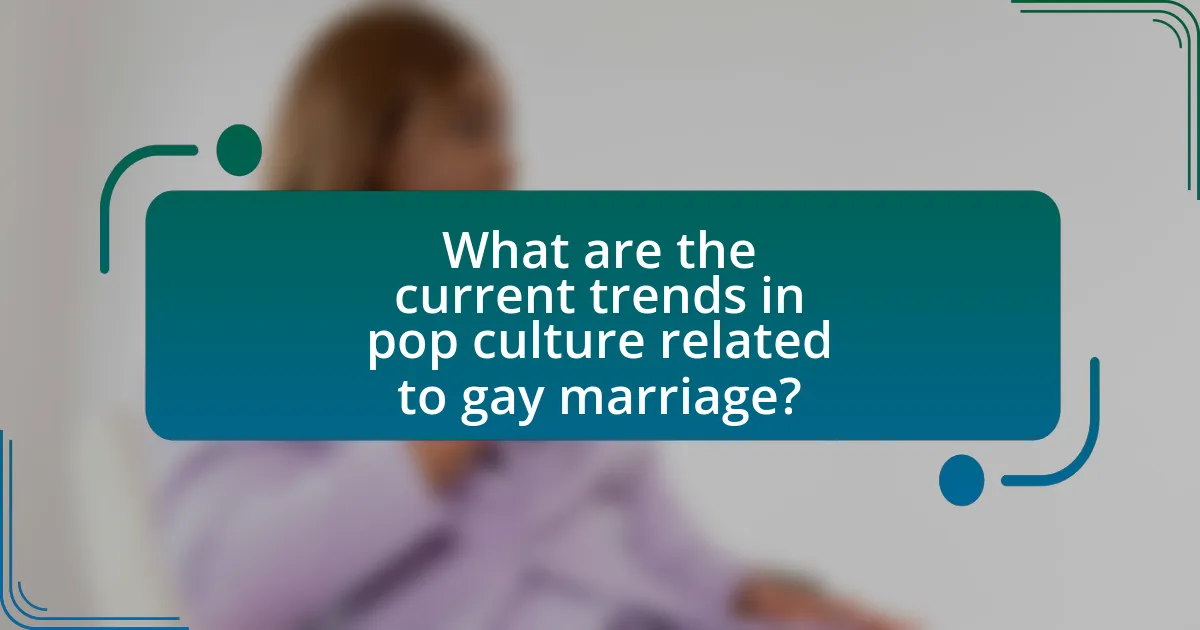
What are the current trends in pop culture related to gay marriage?
Current trends in pop culture related to gay marriage include increased representation in media, with television shows and films featuring LGBTQ+ characters and storylines that normalize same-sex relationships. For instance, popular series like “Schitt’s Creek” and “Pose” have received critical acclaim for their portrayal of gay relationships, contributing to broader acceptance. Additionally, high-profile celebrity endorsements and public figures openly supporting gay marriage have further influenced societal attitudes, as seen in campaigns by artists like Taylor Swift and Ellen DeGeneres. These trends reflect a significant shift in cultural narratives, promoting inclusivity and acceptance of gay marriage in mainstream society.
How are new forms of media, like streaming services, changing the narrative around gay marriage?
New forms of media, particularly streaming services, are significantly changing the narrative around gay marriage by providing diverse and authentic representations of LGBTQ+ relationships. Streaming platforms like Netflix and Hulu have produced numerous original series and films that center on gay characters and their experiences, such as “Heartstopper” and “Pose,” which showcase the complexities of love and commitment in same-sex relationships. These narratives contribute to normalizing gay marriage by depicting it as a natural and integral part of contemporary society, thereby influencing public perception positively. Research indicates that increased visibility of LGBTQ+ characters in media correlates with greater acceptance of gay marriage among viewers, as evidenced by a 2019 study published in the Journal of Homosexuality, which found that exposure to positive portrayals of gay relationships leads to more favorable attitudes toward marriage equality.
What impact do original series on streaming platforms have on perceptions of gay marriage?
Original series on streaming platforms positively influence perceptions of gay marriage by increasing visibility and representation of LGBTQ+ relationships. Studies indicate that exposure to diverse narratives, such as those found in popular streaming series, can lead to greater acceptance and normalization of gay marriage among viewers. For instance, a 2019 study published in the Journal of Homosexuality found that individuals who watched LGBTQ+ inclusive content reported more supportive attitudes toward same-sex marriage compared to those who did not. This suggests that original series serve as a powerful tool in shaping societal attitudes and fostering understanding of gay marriage.
How do documentaries and reality shows address the topic of gay marriage?
Documentaries and reality shows address the topic of gay marriage by showcasing personal stories, societal challenges, and legal battles faced by LGBTQ+ couples. These media formats often highlight the emotional and legal aspects of marriage equality, providing viewers with relatable narratives that foster empathy and understanding. For instance, documentaries like “The Case Against 8” detail the fight for same-sex marriage in California, illustrating the complexities of the legal system and the personal stakes involved. Reality shows, such as “Say Yes to the Dress: Atlanta,” feature same-sex couples planning their weddings, normalizing their experiences and promoting acceptance among broader audiences. This representation in popular culture has been shown to influence public attitudes positively, as evidenced by a 2015 study published in the journal “Social Science Quarterly,” which found that exposure to LGBTQ+ representation in media correlates with increased support for same-sex marriage.
What challenges remain in the portrayal of gay marriage in pop culture?
Challenges in the portrayal of gay marriage in pop culture include persistent stereotypes, limited representation, and backlash from conservative groups. Stereotypes often reduce complex characters to one-dimensional figures, which can perpetuate misunderstandings about LGBTQ+ relationships. Limited representation occurs when gay marriage is underrepresented in mainstream media, leading to a lack of visibility and normalization. Additionally, backlash from conservative groups can result in censorship or negative portrayals, hindering positive narratives. These challenges impact societal attitudes and the acceptance of gay marriage, as media plays a crucial role in shaping public perception.
How do stereotypes in media affect the representation of gay marriage?
Stereotypes in media significantly distort the representation of gay marriage by perpetuating narrow and often negative portrayals of LGBTQ+ relationships. These portrayals can reinforce societal biases, leading to misconceptions about the nature of gay marriages, such as depicting them as less valid or serious compared to heterosexual marriages. Research indicates that media representations heavily influence public perception; for instance, a study published in the Journal of Homosexuality found that exposure to positive portrayals of gay relationships in media correlates with increased support for gay marriage among viewers. Thus, the media’s reliance on stereotypes can hinder progress toward acceptance and equality by shaping attitudes that reflect outdated or harmful views.
What are the criticisms of how gay marriage is depicted in pop culture?
Criticisms of how gay marriage is depicted in pop culture include the oversimplification of LGBTQ+ relationships, the reinforcement of stereotypes, and the lack of diverse representation. Many portrayals reduce complex relationships to comedic or dramatic tropes, failing to capture the genuine experiences of same-sex couples. For instance, shows often depict gay relationships as primarily focused on sexual identity rather than emotional depth, which can mislead audiences about the realities of these partnerships. Additionally, stereotypes such as the flamboyant gay man or the butch lesbian can perpetuate narrow views of LGBTQ+ individuals, overshadowing the diversity within the community. Research from the Williams Institute indicates that media representation significantly influences public perception, suggesting that these portrayals can shape societal attitudes toward gay marriage in both positive and negative ways.
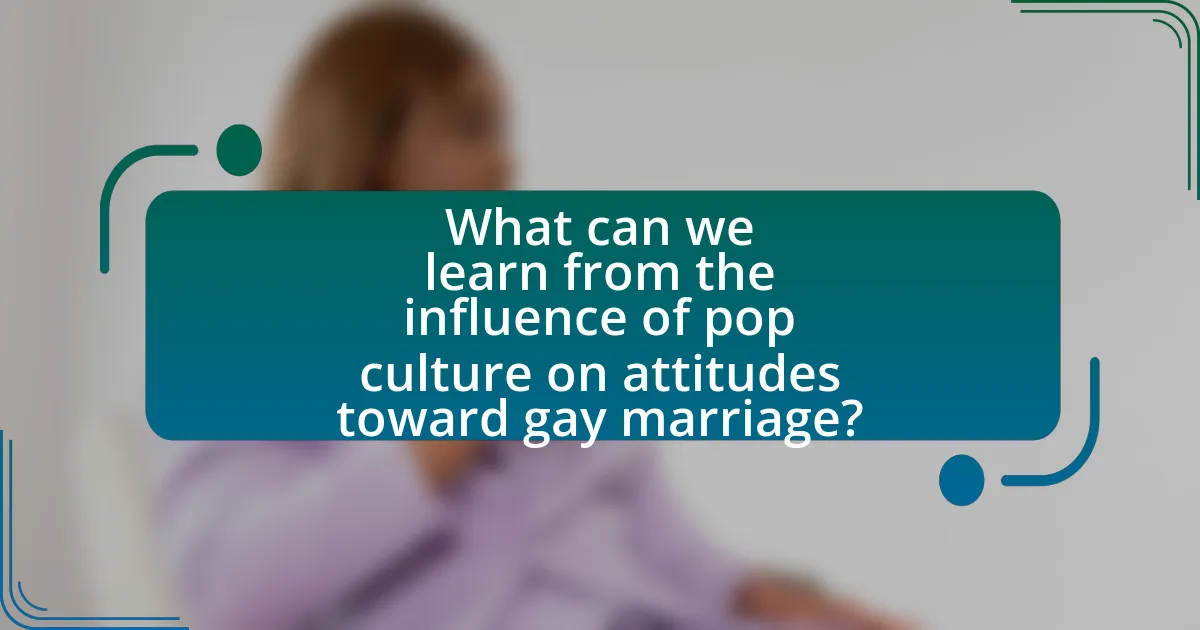
What can we learn from the influence of pop culture on attitudes toward gay marriage?
The influence of pop culture on attitudes toward gay marriage demonstrates that media representation can significantly shift public perception. For instance, television shows like “Will & Grace” and “Modern Family” have contributed to increased acceptance of LGBTQ+ relationships, as evidenced by a 2013 study published in the Journal of Homosexuality, which found that exposure to positive portrayals of gay characters correlated with more favorable attitudes toward same-sex marriage. This indicates that pop culture not only reflects societal changes but also actively shapes them by normalizing and humanizing LGBTQ+ experiences.
How can pop culture be leveraged to further promote acceptance of gay marriage?
Pop culture can be leveraged to promote acceptance of gay marriage by utilizing influential media platforms, such as television, film, and social media, to portray positive representations of LGBTQ+ relationships. For instance, shows like “Modern Family” and “Will & Grace” have significantly contributed to changing perceptions by normalizing gay relationships and showcasing them in relatable contexts. Research indicates that exposure to positive LGBTQ+ representation in media correlates with increased acceptance; a study published in the Journal of Homosexuality found that individuals who consume media featuring LGBTQ+ characters are more likely to support gay marriage. By continuing to highlight diverse narratives and fostering empathy through storytelling, pop culture can effectively challenge stereotypes and promote broader societal acceptance of gay marriage.
What strategies can be employed by advocates to utilize pop culture effectively?
Advocates can employ strategies such as leveraging popular media, collaborating with influencers, and creating relatable narratives to utilize pop culture effectively. By integrating messages about gay marriage into mainstream television shows, films, and music, advocates can normalize the conversation and reach wider audiences. Collaborating with influencers who resonate with younger demographics can amplify these messages, as studies show that social media influencers significantly impact attitudes and behaviors. Additionally, crafting relatable narratives that reflect personal stories can evoke empathy and understanding, making the topic more accessible. These strategies are supported by research indicating that exposure to positive representations in pop culture can shift public perceptions and attitudes toward gay marriage.
How can individuals engage with pop culture to support gay marriage rights?
Individuals can engage with pop culture to support gay marriage rights by actively participating in media that promotes LGBTQ+ representation and advocacy. This includes watching films, television shows, and documentaries that highlight gay marriage stories, such as “Moonlight” and “Love, Simon,” which have contributed to shifting societal attitudes toward acceptance. Additionally, individuals can support artists, musicians, and influencers who openly advocate for gay marriage rights, amplifying their messages through social media platforms. Research indicates that increased visibility of LGBTQ+ narratives in pop culture correlates with greater public support for gay marriage, as seen in a 2015 study by the Williams Institute, which found that exposure to LGBTQ+ media significantly influences attitudes. By consuming and sharing this content, individuals can foster a more inclusive cultural landscape that supports gay marriage rights.
